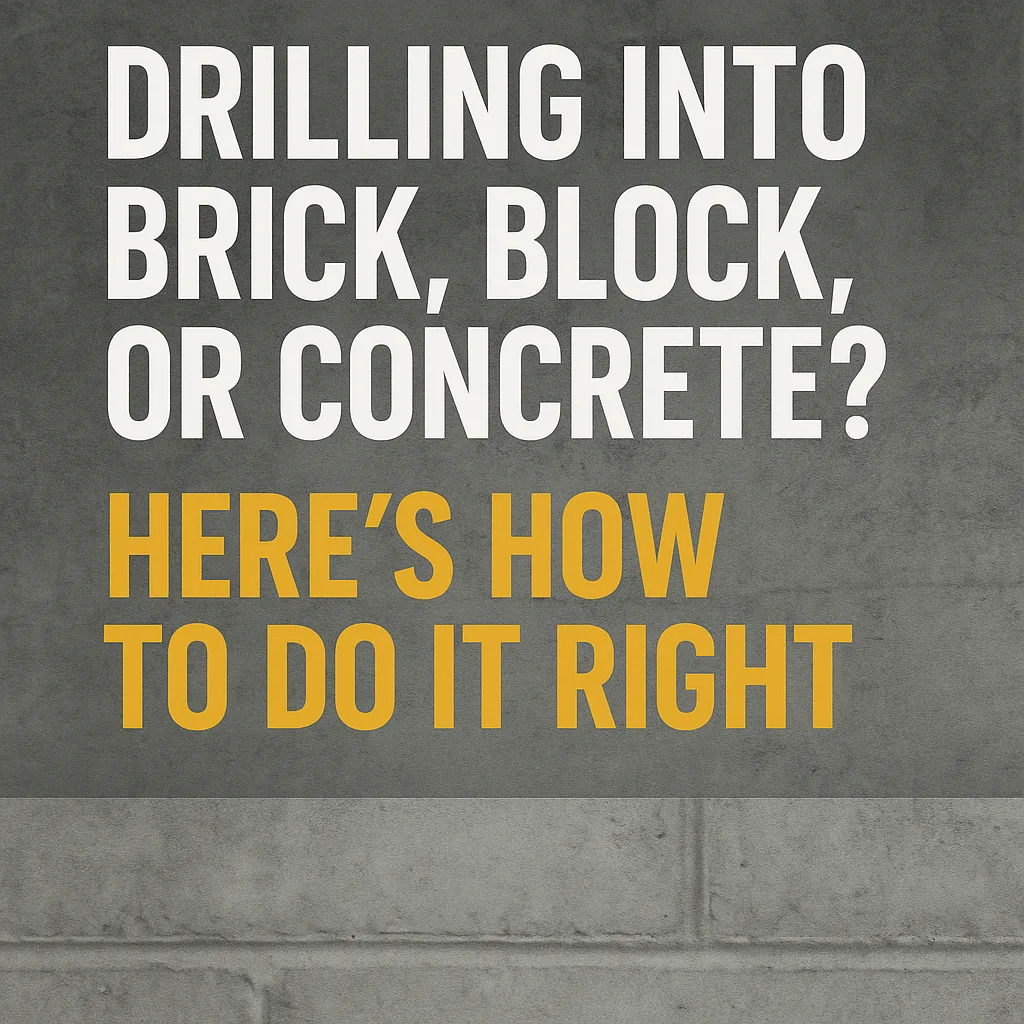New! DIY Project Planner. Plan smarter, skip the spreadsheets. Start Your Free Trial Today →

Wondering how to drill into brick, block, or concrete without cracking your wall? You’re not alone — and the good news is, it’s easier than it looks. Whether you’re anchoring into brick, mounting on block, or drilling through poured concrete, this guide shows you exactly how to do it without damage, frustration, or wasted anchors.
Brick, concrete, and block walls are tough materials — and they’ll stay that way if you use the right approach. The biggest mistake most people make is grabbing a regular drill, punching a hole with a wood bit, and hoping for the best. That’s how you end up with cracked brick faces, uneven holes, or anchor failures.
Whether you’re mounting a TV, installing shelves, or adding outdoor hardware, drilling into masonry the wrong way can ruin your wall — and your confidence. This guide walks you through how to drill into brick, concrete, or block walls safely and cleanly — using the right gear, the right method, and a few pro-level tricks.
Affiliate disclosure: Some links in this post are affiliate links, meaning we may earn a small commission if you click through and make a purchase. It doesn’t cost you anything extra, and it helps support our team. We only recommend tools we trust.
You don’t need an expensive contractor setup, but you do need the right gear. Here’s what works:
Want a quick crash course on anchor sizes? Check out our guide on what size wall anchors to use — it clears up all the guesswork.
Brick and block walls have mortar joints — softer, more forgiving areas between bricks or blocks. Drilling directly into the mortar is easier but weaker for heavy loads. Brick and block faces are stronger but more prone to cracking.
For mounting anything heavy, drill into the brick or block itself, not the mortar. For light-duty work like picture frames or outdoor lighting, mortar is fine.
Use masking tape to mark your drill point and to help keep the bit from wandering. This is especially helpful on smooth brick or block surfaces.
If you’re using a basic cordless drill, this is the project that justifies upgrading to a hammer drill. It’s worth the investment. Hammer drills pulse as they spin, helping the bit chip through masonry — you won’t get far without one.
Attach a carbide-tipped masonry bit to your drill, set the hammer function, and go slow to start.
Start with low pressure and slow speed until the bit grabs. Once you’re about 1/8 inch in, you can pick up speed — but don’t force it. Pause every few seconds to clear dust by backing out the bit.
If you’re hitting really hard material (like poured concrete), go slow, back out more often, and take breaks to prevent overheating the bit.
Once you’ve hit your desired depth (most masonry anchors are 1 ½” to 2″), vacuum out the hole. Insert the anchor or screw, mount your bracket or hardware, and you’re done.
✅ Use the right anchor for your wall type — sleeve anchors or Tapcons for solid brick/concrete, plastic expansion anchors for lighter loads in block.
✅ Mark your bit with tape to avoid drilling too deep
✅ If the wall is painted, score the surface lightly with a punch or awl to prevent chipping
✅ Keep extra masonry bits handy — they wear down faster than metal bits
✅ If working outdoors, check the weather — moisture can affect anchor hold
❌ Don’t use wood bits or twist bits — they’ll dull or snap
❌ Don’t force the drill — let the hammer action work
❌ Don’t use drywall anchors in brick or block — they’re not strong enough
❌ Don’t drill into cracked brick or mortar — find a solid area instead
❌ Don’t mount heavy shelves with only one anchor — always use at least two
Drilling into brick, concrete, or block doesn’t have to be intimidating. With a good hammer drill, a masonry bit, and a plan, you can install just about anything — without damaging your wall. The key is knowing what tools to use, where to drill, and how to finish clean.
Start with something small like a hose holder or outdoor light bracket. Once you’ve done it once, you’ll be confident enough to handle shelves, brackets, or even a wall-mounted TV on masonry.